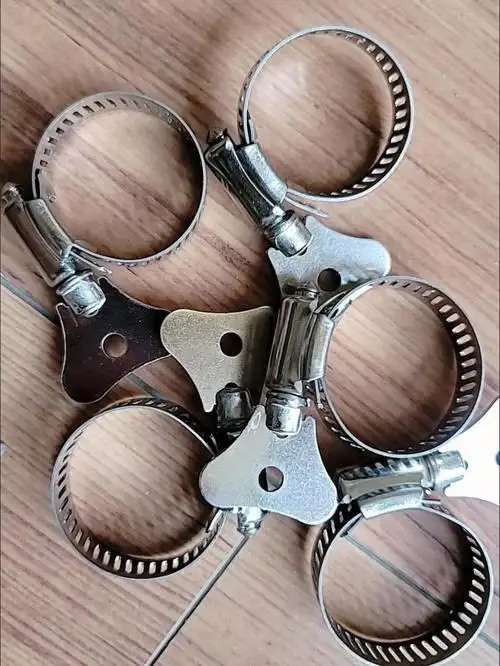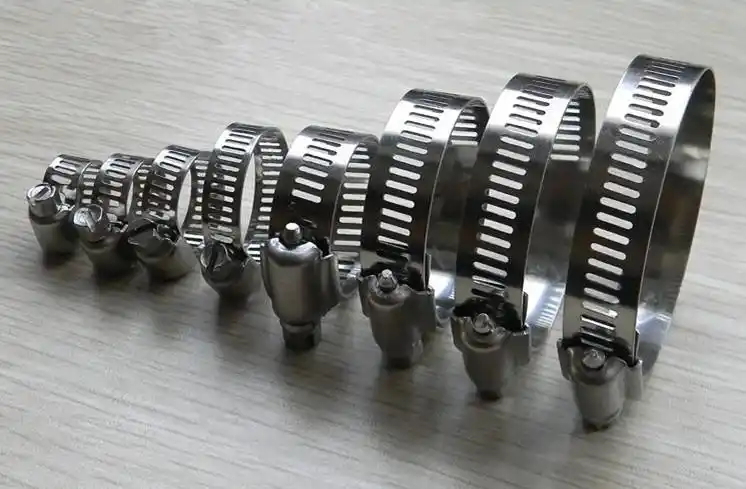How to Size a Hose Clamp: A Comprehensive Guide
Hose clamps are essential components in various applications, from automotive to plumbing, and even in industrial settings. They are used…
Hose clamps are essential components in various applications, from automotive to plumbing, and even in industrial settings. They are used to secure hoses onto fittings, ensuring a tight seal and preventing leaks. However, selecting the right size hose clamp is crucial for its effectiveness. An improperly sized clamp can lead to leaks, hose damage, or even complete failure of the system. This article will guide you through the process of sizing a hose clamp correctly, ensuring a secure and reliable connection.

Understanding Hose Clamps
Before diving into the sizing process, it’s important to understand what hose clamps are and the different types available. Hose clamps are devices used to attach and seal a hose onto a fitting, such as a nipple or barb. They come in various designs, including:
1.Worm Gear Clamps: These are the most common type, featuring a screw mechanism that tightens the clamp around the hose.
2.Spring Clamps: These clamps use spring tension to hold the hose in place and are often used in automotive applications.
3.T-Bolt Clamps: These are heavy-duty clamps used in high-pressure applications, featuring a T-bolt for tightening.
4.Ear Clamps: Also known as Oetiker clamps, these are single-use clamps that are crimped into place.
Each type of clamp has its own advantages and is suited for specific applications. However, the sizing principles remain largely the same across different types.
Steps to Size a Hose Clamp
1. Measure the Hose Diameter
The first step in sizing a hose clamp is to determine the outer diameter (OD) of the hose. This is the most critical measurement, as it directly affects the clamp’s ability to secure the hose properly.
- Using a Caliper: For the most accurate measurement, use a caliper to measure the hose’s outer diameter. Place the caliper around the hose and record the measurement.
- Using a Tape Measure: If a caliper is not available, you can use a flexible tape measure. Wrap the tape around the hose to measure its circumference, then divide the circumference by π (3.1416) to get the diameter.
2. Determine the Clamp Size
Once you have the hose’s outer diameter, you can select the appropriate clamp size. Hose clamps are typically sized by their diameter range, which indicates the minimum and maximum hose diameters they can accommodate.
- Check the Manufacturer’s Specifications: Most hose clamps come with a size range printed on the packaging or in the product description. Ensure that the hose’s outer diameter falls within this range.
- Consider the Clamp’s Adjustment Range: Worm gear clamps, for example, have an adjustable range. Make sure the clamp can be tightened sufficiently to secure the hose without over-tightening, which could damage the hose.
3. Consider the Hose Material and Application
The material of the hose and the application it will be used in can also influence the choice of hose clamp.
- Hose Material: Softer materials like silicone or rubber may require a clamp with a wider band to distribute pressure evenly and prevent damage. Harder materials like PVC may require a more robust clamp.
- Application: High-pressure applications, such as in hydraulic systems, may require heavy-duty clamps like T-bolt clamps. In contrast, low-pressure applications, like household plumbing, may only need standard worm gear clamps.
4. Account for Temperature and Environmental Factors
The operating environment can also affect the choice of hose clamp.
- Temperature: If the hose will be exposed to high temperatures, ensure that the clamp material can withstand the heat without losing its clamping force. Stainless steel clamps are often preferred for high-temperature applications.
- Corrosion Resistance: In environments where the clamp may be exposed to moisture or chemicals, choose a clamp made from corrosion-resistant materials like stainless steel or coated metals.
5. Test the Fit
After selecting a clamp based on the above criteria, it’s important to test the fit before final installation.
- Dry Fit: Place the clamp around the hose and fitting without tightening it. Ensure that the clamp sits evenly around the hose and that there are no gaps.
- Tighten the Clamp: Gradually tighten the clamp using the appropriate tool (e.g., a screwdriver for worm gear clamps). Ensure that the clamp is snug but not over-tightened, as this could damage the hose or fitting.
6. Inspect and Maintain
Once the clamp is installed, regular inspection and maintenance are essential to ensure its continued effectiveness.
- Visual Inspection: Periodically check the clamp for signs of wear, corrosion, or loosening. Replace any clamps that show signs of damage.
- Re-tightening: Over time, clamps may loosen due to vibration or temperature changes. Re-tighten the clamp as necessary to maintain a secure connection.

Common Mistakes to Avoid
- Using the Wrong Size Clamp: Using a clamp that is too small can cause the hose to be compressed too tightly, leading to damage. Conversely, a clamp that is too large may not provide a secure seal.
- Over-Tightening: Over-tightening a clamp can crush the hose, reducing its lifespan and potentially causing leaks. Always tighten the clamp just enough to secure the hose without excessive force.
- Ignoring Environmental Factors: Failing to consider temperature, pressure, and environmental conditions can lead to premature clamp failure. Always choose a clamp that is suited to the specific application.
Sizing a hose clamp correctly is a critical step in ensuring a secure and reliable connection. By accurately measuring the hose diameter, considering the hose material and application, and accounting for environmental factors, you can select the appropriate clamp for your needs. Regular inspection and maintenance will further ensure the longevity and effectiveness of the clamp. Whether you’re working on a car, plumbing system, or industrial machinery, taking the time to size your hose clamp correctly will save you from potential headaches and costly repairs down the line.
Problems encountered and solutions
Inaccurate measurement problem
Problem manifestation
When measuring the outer diameter of the hose, the measuring tool is used improperly or the measuring position is inaccurate, resulting in measurement deviation.
For non-circular or irregular hoses, it is difficult to determine the accurate measurement point and measurement method.
Solution
Use accurate measuring tools, such as calipers, to ensure that the caliper is perpendicular to the hose during measurement, and the measurement position is on the flat part of the hose, avoiding measurement at bends or bulges.
For irregular hoses, use a soft ruler to measure the circumference of the hose, and then calculate the equivalent outer diameter using the circumference formula. You can also measure the diameters at several different locations and take the average value.

Problems with hose material characteristics
Problem manifestation
Hose material is elastic. After installing the hose clamp, the hose may be deformed due to pressure, resulting in the actual size being different from the size measured before installation.
Hoses of different materials will expand and contract at different temperatures, affecting the adaptability of the hose clamp.
Solution
When measuring, apply a certain pre-pressure to the hose and simulate the state after installation to obtain a more accurate size.
Considering the temperature range of the hose use environment, for materials with obvious thermal expansion and contraction, choose a hose clamp with a certain elasticity and adjustable range, or measure the hose multiple times at different temperatures to determine the appropriate size.
Problems with hose clamp type selection
Problem manifestation
There are many types of hose clamps on the market, such as spring clamps, worm drive clamps, wire clamps, etc., and the lack of understanding of the applicable scenarios of different types leads to wrong selection.
For special application scenarios, such as high pressure, high temperature, corrosion resistance and other environments, I don’t know how to choose a suitable hose clamp.
Solution
Understand the characteristics and applicable scope of different types of hose clamps. Spring clamps are suitable for general low-pressure and small-diameter hoses; worm drive clamps can provide greater clamping force and are suitable for medium and high pressure and larger-diameter hoses; wire clamps are often used in some occasions with high space requirements.
For special environments, choose hose clamps of corresponding materials and structures. For example, in high temperature environments, high-temperature resistant metal hose clamps can be selected; in corrosion-resistant environments, stainless steel or plastic hose clamps are used.
Installation problem
Problem manifestation
If the hose clamp is installed too tightly, it may cause damage and deformation of the hose, affecting the service life of the hose and the fluid delivery efficiency.
If the hose clamp is installed too loosely, it will cause the hose connection to be loose and leak.
Solution
Install according to the installation instructions and recommended torque of the hose clamp, and use tools such as torque wrenches to ensure accurate installation force.
After installation, check and adjust the hose clamp. You can check the firmness of the connection by slightly pulling the hose. If necessary, adjust the tightness of the hose clamp appropriately.

Lack of reference standards
Problem manifestation
For some non-standard hoses or hoses for special applications, there are no clear standards or specifications to guide the size selection of hose clamps.
Hoses and hose clamps from different manufacturers may have size differences, making it difficult to determine a unified adaptation standard.
Solution
Refer to experience data or industry cases for similar application scenarios and consult professional engineers or technicians.
Communicate with the manufacturers of hoses and hose clamps to obtain their technical support and suggestions, and understand the size matching characteristics and applicable scope of their products.








yes